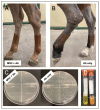Immune Activated Cellular Therapy for Drug Resistant Infections: Rationale, Mechanisms, and Implications for Veterinary Medicine
- PMID: 36356087
- PMCID: PMC9695672
- DOI: 10.3390/vetsci9110610
Immune Activated Cellular Therapy for Drug Resistant Infections: Rationale, Mechanisms, and Implications for Veterinary Medicine
Abstract
Antimicrobial resistance and biofilm formation both present challenges to treatment of bacterial infections with conventional antibiotic therapy and serve as the impetus for development of improved therapeutic approaches. Mesenchymal stromal cell (MSC) therapy exerts an antimicrobial effect as demonstrated in multiple acute bacterial infection models. This effect can be enhanced by pre-conditioning the MSC with Toll or Nod-like receptor stimulation, termed activated cellular therapy (ACT). The purpose of this review is to summarize the current literature on mechanisms of antimicrobial activity of MSC with emphasis on enhanced effects through receptor agonism, and data supporting use of ACT in treatment of bacterial infections in veterinary species including dogs, cats, and horses with implications for further treatment applications. This review will advance the field's understanding of the use of activated antimicrobial cellular therapy to treat infection, including mechanisms of action and potential therapeutic applications.
Keywords: antibiotic resistance; antimicrobial; cell; mesenchymal; stem; stromal.
Conflict of interest statement
The co-authors declare commercial affiliations with Validus Cellular Therapeutics (S.D. co-founder) and eQcell Inc. (L.P., S.D. advisory board and stock options).
Figures


Similar articles
-
Activated Mesenchymal Stromal Cell Therapy for Treatment of Multi-Drug Resistant Bacterial Infections in Dogs.Front Vet Sci. 2022 Jun 23;9:925701. doi: 10.3389/fvets.2022.925701. eCollection 2022. Front Vet Sci. 2022. PMID: 35812842 Free PMC article.
-
TLR-activated mesenchymal stromal cell therapy and antibiotics to treat multi-drug resistant Staphylococcal septic arthritis in an equine model.Ann Transl Med. 2022 Nov;10(21):1157. doi: 10.21037/atm-22-1746. Ann Transl Med. 2022. PMID: 36467344 Free PMC article.
-
Activated Mesenchymal Stem Cells Interact with Antibiotics and Host Innate Immune Responses to Control Chronic Bacterial Infections.Sci Rep. 2017 Aug 29;7(1):9575. doi: 10.1038/s41598-017-08311-4. Sci Rep. 2017. PMID: 28851894 Free PMC article.
-
Antimicrobial Properties of Equine Stromal Cells and Platelets and Future Directions.Vet Clin North Am Equine Pract. 2023 Dec;39(3):565-578. doi: 10.1016/j.cveq.2023.06.005. Epub 2023 Jul 11. Vet Clin North Am Equine Pract. 2023. PMID: 37442729 Review.
-
Mesenchymal Stromal Cells as Potential Antimicrobial for Veterinary Use-A Comprehensive Review.Front Microbiol. 2020 Dec 1;11:606404. doi: 10.3389/fmicb.2020.606404. eCollection 2020. Front Microbiol. 2020. PMID: 33335522 Free PMC article. Review.
Cited by
-
Biochemistry of Bacterial Biofilm: Insights into Antibiotic Resistance Mechanisms and Therapeutic Intervention.Life (Basel). 2025 Jan 2;15(1):49. doi: 10.3390/life15010049. Life (Basel). 2025. PMID: 39859989 Free PMC article. Review.
-
Preliminary evaluation of safety and migration of immune activated mesenchymal stromal cells administered by subconjunctival injection for equine recurrent uveitis.Front Vet Sci. 2023 Dec 14;10:1293199. doi: 10.3389/fvets.2023.1293199. eCollection 2023. Front Vet Sci. 2023. PMID: 38162475 Free PMC article.
References
-
- CDC Antibiotic Resistance Threats in the United States. [(accessed on 4 April 2022)];2013 Available online: https://www.cdc.gov/drugresistance/threat-report-2013/pdf/ar-threats-201....
-
- World Health Organization (WHO) Antimicrobial Resistance. 2018. [(accessed on 4 April 2022)]. Available online: https://www.who.int/news-room/fact-sheets/detail/antimicrobial-resistance.
Publication types
Grants and funding
LinkOut - more resources
Full Text Sources
Miscellaneous

